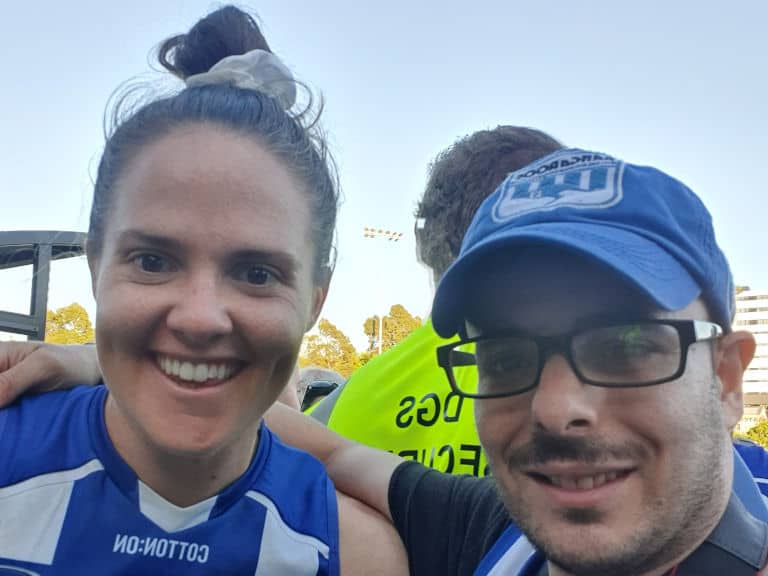
Back when I played footy as a kid, there was one player that stood out above all my teammates. Fast, skillful, brave, and every bit a part of the team. My friend Shannon was one of the captains in the U13’s and one of the best players in the league. That was the last year I could play with Shannon, “football is only for the boys” we were told.
In the last ten years however that has all changed, there are now enough girls to have there own teams, playing In there own competitions, there is now a professional woman’s competition, the ever growing AFLW, elite junior pathways, 2nd tier state comps, and an ever growing number of inspired girls who no finally have a generation of role models to look up too.
I’ve included here the main differences between the women’s game and the men’s game, and how bright the outlook is for the women’s.
Quicker Game Time
An AFLW game goes for 92 minutes, including four 15 minute quarters, two 6 minute breaks at quarter time, and one 20 minute break at half time. Added time can be added on in accordance with AFL rules.
In comparison, a men’s AFL game includes 20 minutes of regular time for a quarter. These can stretch to over 30 minutes with additional time.
A Shorter Season
An AFLW season is played over 10 weeks. The AFLW season starts in early February and ends in early April.
This schedule is believed to have been set by the AFL so that the AFLW does not compete with the Australian Open tennis and the beginning of the regular AFL men’s season.
The AFL men’s season is played over 23 regular weeks plus finals. It starts towards the end of March and ends in September.
In contrast to the shorter AFLW season, at state and local level, including the elite Under 18’s, the competitions are run simultaneously with the regular AFL men’s season. Even considering most of the AFLW players draft from these elite Under 18’s (we wrote about how to get drafted recently, check it out here: https://anybodysfan.com/how-to-get-drafted-into-the-afl/).
A short season makes it harder to introduce new teams. despite more teams and more games, the AFL continues to try and squeeze more games into the same time frame. This has also seen the introduction of the conference system with the 14 AFLW teams split between 2 conferences.
Each team plays each of their conference rivals once and one other game against an opponent from the other conference. Many of the fans, players, and clubs were unhappy with this: The season feels too short to be professional, and that there would not be a true indication of who the best teams were given you didn’t have to play half the other teams during the season.
In the AFLW, there are 6 team finals series, comprising 3 from each conference. The best team of each conference is determined from these finals games similar to the AFL men’s. There is a showcase Grand Final played between the last two teams.
Fewer Players on the Field
In an AFLW game, there are 16 players on the field. The team is arranged in a 5-6-5 configuration with 5 forwards, 6 midfield, and 5 defenders.
An AFL men’s game has 18 players on the field. By comparison, the men’s game is 6-6-6: 6 forwards, 6 midfield, and 6 defenders.
I reckon it’s a good idea to play with less players on the field. Less players allows for more space and less congestion; there would be better ball movement and higher scoring. There was discussion about dropping the men’s match player number to 16 as well. I’d like to see that happen too.
Smaller Ball Size
AFLW matches are played with a size 4.5 Sherrin football made according to league specifications. This is slightly smaller than the men’s AFL competition.
The men’s competition use a size 5 Sherrin football.
I wrote a guide on what the different ball sizes mean, and how the different brands compare. Check it out here: anybodysfan.com/afl-footballs-costs-brands-sizes/
Started Recently
AFLW started in 2017 with 8 teams. Research and planning for the AFLW started around 2010 with the first exhibition matches started in 2013. Fans were excited by the women’s matches and the AFL accelerated its implementation of a women’s league.
The AFL men’s competition dates back to 1897 where it grew out of the Victorian Football Association
Looking Forward
Since the introduction of AFLW in 2017 Australian football across the country has seen an increase in female involvement at all levels, in particular juniors have seen a massive spike in participation. Unlike my friend Shannon, who was left without anywhere to play once she reached 13, now there are thousands of junior clubs with girls teams across all age groups and pathways to senior and elite professional levels.
It has been a remarkable turn around. In 2005, 18,609 woman were playing Australian Football, with a huge increase to 48,054 in 2006. In 2018 this had increased to a massive 463,364, making up an impressive 30% of all participants.
While the game has been clearly growing for some time, 2017 would go down as the year female football come of age. In 2016 there were 406 clubs across the nation with female teams, in 2017 this would see a 76% increase, with a massive 1690 clubs with female teams.
As the stats above suggest, Australian football among woman is clearly one of Australia’s biggest sports. AFL clubs now put major resources and time into there female teams and 14 of the clubs participate in the AFLW. The remaining 4 AFL clubs Essendon, Hawthorn, Port Adelaide and Sydney all compete at lower levels with a desire to join the AFL in the near future.
It only goes to reason with more teams the game will grow in popularity. The game has seen major changes in pay, sponsorship and interest levels, leading to greater professionalism and an increase in young girls choosing Australian Football as a potential career pathway, something that was almost impossible nearly 20 years ago.
References
- AFL rules for the length of AFLW games here
- AFLW season timing explained here
- Report on the AFLW conference system here
- Explanation of the 5-6-5 player positions here
- Ball sizes guide here
- Source for AFLW growth statistics
My Time With Shannon
On the first day of training in a new age group however, Shannon was no-where to be seen, “where is Shan?” we all asked. At first the adults didn’t want to address it, then one day Shan’s dad came down, angry and upset and visibly arguing with the coaches and the coordinators, something was up and that night after training the coaches called everyone in for a meeting. Why was Shannon’s dad so angry? Why was one of our best players not training with us this year?
We got the answer that night and one I still can’t fully comprehend. Shannon was to old to play with the boys. As you have probably realised Shannon is a girl and was a bloody talented one, but like so many young girls when I was a kid, they would be told at an early age that footy wasn’t for them. “To dangerous” and “only for the boys.”
That was nearly 20 years ago and for the next 10 years, as I continued to play through the age groups and took up some junior coaching I saw the frustration and heartbreak time and time again of young girls being told they could not play anymore.
